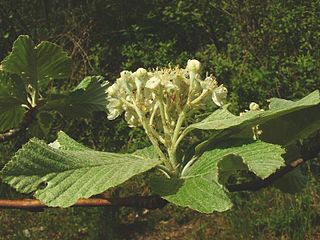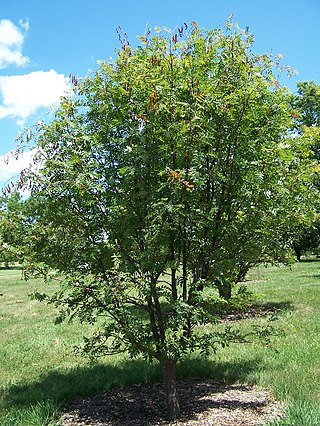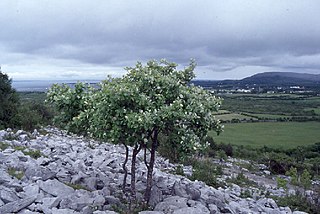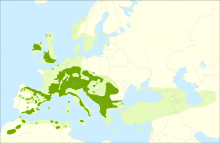
Sorbus is a genus of over 100 species of trees and shrubs in the rose family, Rosaceae. Species of Sorbus (s.l.) are commonly known as whitebeam, rowan (mountain-ash) and service tree. The exact number of species is disputed depending on the circumscription of the genus, and also due to the number of apomictic microspecies, which some treat as distinct species, but others group in a smaller number of variable species. Recent treatments classify Sorbus in a narrower sense to include only the pinnate leaved species of subgenus Sorbus, raising several of the other subgenera to generic rank.

The whitebeams are members of the family Rosaceae, comprising subgenus Aria of genus Sorbus, and hybrids involving species of this subgenus and members of subgenera Sorbus, Torminaria and Chamaemespilus. They are deciduous trees with simple or lobed leaves, arranged alternately. They are related to the rowans, and many of the endemic restricted-range apomictic microspecies of whitebeam in Europe are thought to derive from hybrids between S. aria and the European rowan S. aucuparia; some are also thought to be hybrids with the wild service tree S. torminalis, notably the service tree of Fontainebleau Sorbus latifolia in French woodlands.

Ilex aquifolium, the holly, common holly, English holly, European holly, or occasionally Christmas holly, is a species of flowering plant in the family Aquifoliaceae, native to western and southern Europe, northwest Africa, and southwest Asia. It is regarded as the type species of the genus Ilex, which by association is also called "holly". It is an evergreen tree or shrub found, for example, in shady areas of forests of oak and in beech hedges. In the British Isles it is one of very few native hardwood evergreen trees. It has a great capacity to adapt to different conditions and is a pioneer species that repopulates the margins of forests or clearcuts.

Pyrus salicifolia is a species of pear, native to the Middle East. It is widely grown as an ornamental tree, almost always as a pendulous cultivar, and is called by various common names, including willow-leaved pear, weeping pear, and similar. The tree is deciduous and of comparatively small stature, rarely reaching 10–12 meters in height. The crown is rounded. It has pendulous, silvery foliage, superficially similar to a weeping willow. The flowers are large and pure white highlighted with black-tipped stamens although the buds are tipped with red. The small green fruits are inedible, being hard and astringent.

Karpatiosorbus latifolia is a species of whitebeam that is endemic to the area around Fontainebleau, south of Paris in France, where it has been known since the early eighteenth century.

Ligustrum lucidum, the broad-leaf privet, Chinese privet, glossy privet, tree privet or wax-leaf privet, is a species of flowering plant in the olive family Oleaceae, native to the southern half of China and naturalized in many places. The name "Chinese privet" is also used for Ligustrum sinense.
Sorbus pseudomeinichii, known as false rowan and Catacol whitebeam, is a rare tree endemic to the Isle of Arran in south west Scotland. It is believed to have arisen as a hybrid of the native rowan and the cut-leaved whitebeam which is in turn a rowan/Arran whitebeam hybrid. Until 2020 only two specimens of the Catacol whitebeam were known, at the time making it the rarest tree not only in Scotland, but joint rarest in the world with Wood's cycad, both with only one specimen living. A third was recorded as a sapling, but is believed to have been destroyed by deer. A seedling and grafted plants have also been grown in Edinburgh.

Sorbus eminens, the round-leaved whitebeam, sometimes classified as Aria eminens when the Aria subgenus of Sorbus is elevated to full genus, is a species of plant in the family Rosaceae. It is endemic to Great Britain. It is threatened by habitat loss.
Sorbus lancastriensis, the Lancashire whitebeam, is a species of deciduous tree or shrub in the family Rosaceae, growing to 6 m (20 ft). It is endemic to England, and is found within a 30 km (19 mi) radius from Morecambe Bay, in Lancashire. It is threatened by habitat loss. It has oval leaves. White blossom in spring is followed by orange to red berries in autumn.

Sorbus commixta, the Japanese rowan, is a species of flowering plant in the family Rosaceae, native to Japan, Sakhalin, and the Korean island of Ulleungdo.

Sorbus × hybrida, the oakleaf mountain ash, Swedish service-tree or Finnish whitebeam, is a hybrid species of whitebeam native to Norway, eastern Sweden, southwestern Finland, and locally in Latvia.

Sorbus sargentiana, Sargent's rowan is a species of flowering plant in the family Rosaceae, native to southwestern Sichuan and northern Yunnan in China, where it grows at altitudes of 2,000–3,200 m (6,560–10,500 ft).

Gaultheria mucronata, the prickly heath, is a species of flowering plant in the family Ericaceae, native to southern Argentina and Chile.

Erica lusitanica is a species of flowering plant in the family Ericaceae, known by the common names Portuguese heath and Spanish heath. It is native to Portugal, Spain and southwestern France. It is named for Lusitania, a historical region encompassing most of modern Portugal and parts of western Spain.

Sorbus vilmorinii, the Vilmorin's rowan or Vilmorin's mountain ash, is a species of flowering plant in the family Rosaceae, native to Sichuan, Tibet and Yunnan in China.

Karpatiosorbus devoniensis is known by the English name of Devon whitebeam and formally as Broad-leaved Whitebeam. When the fruit was reported as sold at Barnstaple Pannier Market the name French Eagles was used, apart from 1929 when they were reported as eagle-berries. When the trees were reported as seen growing wild on botanical walks they were referred to as French Hails. Broad-leaved white-beam, which was the common name until Devon Whitebeam took over, was used once in 1907. The term Otmast was used once as a pet name, as its true identity was not known. It is a species of whitebeam, trees and shrubs in the family Rosaceae. It is endemic to the British Isles, growing wild in areas of Devon, Cornwall, Somerset and south-east Ireland as a native and north-east Ireland as an introduction.

Acer palmatum, commonly known as Japanese maple, palmate maple, or smooth Japanese maple (Japanese: irohamomiji, イロハモミジ, or momiji,, is a species of woody plant native to Japan, Korea, China, eastern Mongolia, and southeast Russia. Many different cultivars of this maple have been selected and they are grown worldwide for their large variety of attractive forms, leaf shapes, and spectacular colors.
Karpatiosorbus houstoniae, or Houston's whitebeam, is a hybrid of two deciduous trees: the common whitebeam and the Bristol whitebeam. Only a single example of the hybrid is known to exist, at the Avon Gorge in Bristol, England. The only specimen grows on a cliff below Stokeleigh Camp at Leigh Woods in North Somerset and cannot be accessed without ropes.
Sorbus thibetica (康藏花楸), the Tibetan whitebeam, is a species of flowering plant in the family Rosaceae, native to south western China and the Himalayas. Growing to 20 m (66 ft) tall by 15 m (49 ft) broad, it is a substantial deciduous tree. Like other whitebeams, the undersides of the leaves are white, giving a dramatic effect when the wind blows through them.

Sorbus hibernica, the Irish whitebeam, is a species of whitebeam endemic to Ireland. It occurs in most counties, usually as scattered individuals, or in small groups. It is sometimes treated as a species in the genus Aria, as Aria hibernica.



















